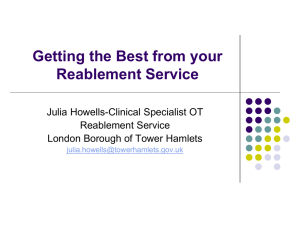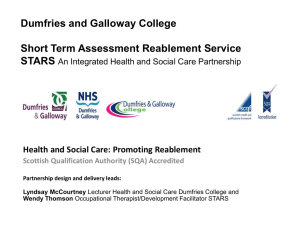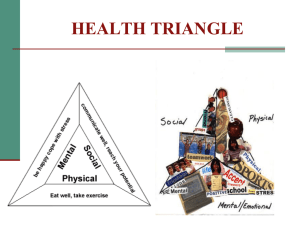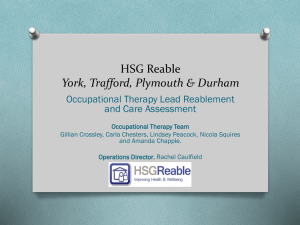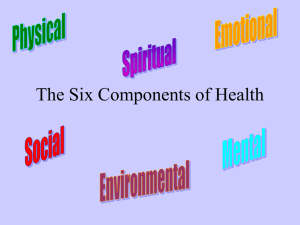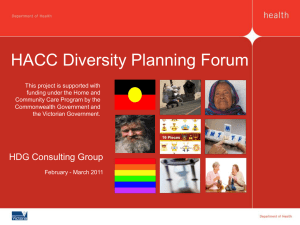How to put Wellness & Reablement at the Centre of Support
advertisement
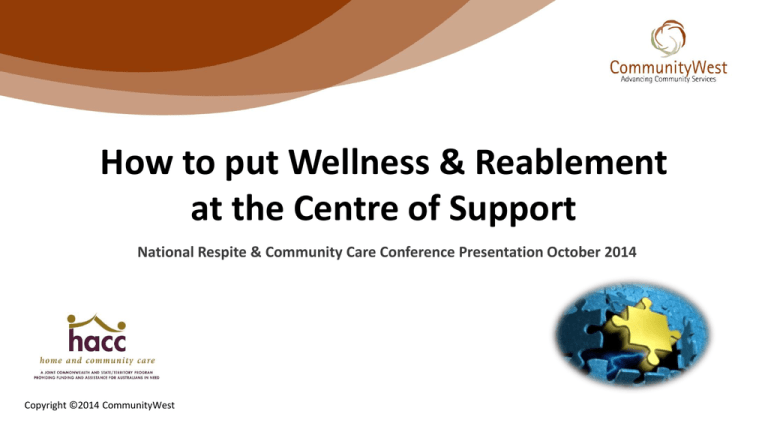
How to put Wellness & Reablement at the Centre of Support National Respite & Community Care Conference Presentation October 2014 Copyright ©2014 CommunityWest Reforms to community care: wellness & reablement themes • Productivity Commission Inquiry 2011 (Home Care). • National Aged Care Alliance 2013. • Commonwealth Home Care Package Guidelines 2014. • Commonwealth – Key directions for the CHSP Discussion Paper 2014. • Adoption of Wellness paradigm. • Promotion of independence/wellness for all. • Time limited restorative care & overarching wellness approach - integrated and across all existing home support services. • CDC packages – reablement framework, choice and control. - wellness goals built into care plan. 2 Sounds great – but some challenges & opportunities Inherent systemic and cultural challenges threaten the potential of wellness: – ageism is ingrained in society – works against enabling approaches – society devalues older people - low expectations. Insufficient attention by sector to an individual’s healthy ageing, individualised needs and desires – consumers ‘present’ because they have functional incapacity. • current system provides services to address symptoms of functional decline rather than services that could reverse or halt the decline • reablement is essential when individuals experience a ‘hit’ to their independence • clients won’t necessarily choose reablement over more passive options • a providers understanding of the value of reablement is critical. 3 Ethical dilemmas • If people have the capacity to be more independent and less dependent on services, should they be required to do so? • Wellness and reablement require motivation that individuals may not apply themselves: – If I choose to...have people do everything for me, is that OK, even if I have the capacity to do more for myself? – How reablement is presented is critical to take up: • not a ‘choice’ if providers don’t invest in it • how do we present it so people want it? • it’s just “how we support people” Are we all playing the same game? Wellness, reablement & older people: what do we know? Sense of future and hope (I set goals for myself) I am ‘me’ and want to be involved in planning my support We know older people: I want to be part of my community and contribute Support to be as able as I can be Work with me don’t do for me Know what I can do and support me to do it • • • • • • • want health and wellbeing enhanced want to be known and understood want to set goals and be supported in a way that builds capacity to live a good life want choices and individualised support generally enjoy participating but won’t necessarily choose over familiar options can make significant gains, but realise full potential as an outcome not as a motivator when unmotivated - still make gains. 5 Long term outcomes of reablement Individuals who receive a targeted restorative service rather than usual HACC Program home care: • have a reduced likelihood of subsequently using - any home care service for three years - a personal care service for five years • are somewhat less likely to be ACAT assessed within the next 5 years and much less likely to be approved for nursing home high level care • are less likely to die over the next 5 years • represent a much better return on investment. (Long Term Outcomes of Restorative Home Care, Lewin et al 2013) 6 X (policy position) + Y (consumer desires) = a positive outcome If we are here primarily to improve people's health, independence and wellbeing, isn’t it our responsibility to seek every opportunity to support people to live the life they desire to the best of their ability? 7 BUT... • • • • Is the sector ready? Are consumers ready? Are families, carers and communities ready? Is the Australian Government ready? The WA HACC Journey: • 2006 Wellness adopted as policy position across all service delivery • Significant cultural/organisational change – long term change process, still more to do. 8 WA HACC wellness & reablement journey HIP/ PEP (Silver Chain) Wellness adopted Evidence • 1999 Home Independence Program – developed/implemented/evaluated • 2003 Personal Enablement Program developed + implemented • 2006 Wellness Approach. Significant system and organisational change across WA HACC •2005 HIP RCT commenced •2009 HIP/PEP long term outcomes examined •2011 RCT analysis complete •2012 HIP Coordinator model developed (Silver Chain) •2012 Five year HIP/PEP/HACC outcomes analysis complete Expanding models •2013 HIP Dementia model developed and piloted (Silver Chain) WAAF •2010 - 2014 WA Assessment Framework (WAAF) developed and implemented across state •Regional Assessment Services introduced •2014 Pilot Reablement teams in RAS (ACNA at present) •2014 – Interface Reablement with Home Modifications and Assistive Technology 9 Putting wellness at the centre of policy & system development • • • • • Driven by WA HACC Program - underpins policy development Built into policies and program manuals/HACC triennial plans Part of GFR and reporting, workforce training & development Built into Quality review process – mapped to standards Considerable sector consultation, development & support – lead providers and champions – developing and piloting – evaluation – resource development (e.g. self assessment, training, documentation). • Targeted reablement specific funding and development • Key driver of Assessment Framework. 10 Wellness & reablement: centre of organisational strategy/change Potential positive client impacts: • • • • organisational vision/strategic focus review policies/systems and supports/embed wellness practices throughout person’s journey documentation that supports service changes service delivery based on strengths, goals and aspirations • • • • language/marketing and communication (reflect philosophical shift) recruitment strategy/workforce education (right values & attitudes) frontline staff - key to success/enablers routines – built around consumer not service/staff. Advice and problem solving not ‘management’ Shared partnership of responsibilities and expectations Support opportunities beyond formal service delivery Support everyday preferences/choices important to individual not solely organisation Risk reduction through improved skills rather than risk aversion Regular checks to make change improvements 11 Wellness at centre of individual needs: assessment • • • • • • • • State-wide Regional Assessment Services (separate from service provision). Wellness assessors – ongoing professional development. Standardised and integrated assessment processes. Strengths/outcome focused. Solutions outside of standard support. Place lived experiences of client, their priorities and concepts of independence at centre. WAAFI – database to follow referral pathways/journeys/outcomes. Interface with ACAT. Cultural and Spiritual Beliefs Likes & Dislikes Individual’s History Choice and Control Physical Needs Health Needs Emotional Needs Social Needs Risk Appetite Individual’s Goals 12 Putting individual outcomes at the centre of support Wellness outcomes Client outcomes 13 Putting wellness/reablement at the centre of service support Targeted short term reablement Paced plan of support/goals Activity analysis Equipment Exercise/strength prescription Ageing Well Practices Community Connector • Whole of person • Health literacy • Build strengths & capacities • Dementia Partnerships Build social connections & networks. Meaningful activities Ongoing support Organisations working with consumer. Support goals and desires. Carers Support Wellness focussed assessments. Integral to reablement outcomes Home modifications/& assistive technology • Key intervention • Interface with reablement Supporting consumer desires to be enabled to live a good life. 14 Putting wellness at the centre of conversations What has changed for you? What do you want to achieve? Person centred/outcome focused tools Clear goals/desires What’s important to/for What would support your wellbeing? How can we build your capacity? Relationship circles What’s working/not working Failure to gather information from the person can be the biggest barrier to delivering effective support. 15 What would you choose? Elderly male, deteriorating: • Not cooking meals – has lunch at pub. • Some mobility problems. Client desired outcomes: • Continue to go to pub as also a social outlet. • Improve mobility so can get to pub. • Reduce risk of falling. Action: • Staff walked to pub with him (strategies identified). • Walking stick & new shoes purchased. • Strength training exercises & personal alarm • Support aimed at reducing current risks & preventing future problems developing. Standard support Wellness support 16 Simple solutions – Mrs ‘D’ Three calls a day, reablement - personal care and meal preparation. • Visually impaired, has OA, uses a walking frame. Wants to remain independent. • Following assessment, Mrs D was encouraged to participate as fully as possible with washing and dressing, however realised early on that this would ongoing. • Has frozen foods but she struggled to heat, as could not read instructions or see the microwave properly. Was also burning her lunch. • Reablement workers: – moved the microwave closer to the window for additional light – attached large labels with the cooking times written on them (e.g. ‘7 minutes’) to all her meals in the freezer – attached raised, florescent stickers to represent 5, 10 and 15 minutes to the microwave dial. • Mrs D now able to prepare lunch independently. 17 Key enablers for service delivery • • • • • • • • Driven by senior management/embedded in strategic plan. Staged implementation to allow for development and testing. Process map the service delivery journey and determine key actions where wellness is not reflected. Ensure front line staff along with coordinators are engaged throughout as they are key to success. Implementation is easier with new clients as enables more positive expectations to be set from the start of service engagement. Longer term clients can be a slow change process. Engaging and gaining the support of carers and families will impact positively on adoption/outcomes. Time spent messaging the benefits of wellness to individuals, families and the community (i.e. GP’s) is critical. 18 Progressing Wellness & Reablement WA HACC Program - 2014 onwards • Continued development of Regional Assessment Services to deliver reablement. • Production of a reablement specific training package (Silver Chain). • Dementia Partnership Team (AAWA) working with and developing assessors. • Home Modifications and Assistive Technology/equipment – Best Practice Model. – ILCWA – HM & AT assessor development – Interface with Reablement and RAS • Self Directed Supports Project. 19 Conclusion: Embrace – don’t panic • • • • • • • Older people wish to be supported to self care. Governments support this desire through community care. Reablement and Wellness can produce big wins. Passive options are more familiar. How do we support choices that directly improve a person’s independence? Practice changes can make a profound difference. Who stands to lose the most if we don't do this? 20 Useful references 1. WA HACC Wellness Approach – Challenging Community Care with Wellness https://www.communitywest.com.au/resources/cwnews/1204-now-available-challengingcommunity-care-with-wellness-report 2. The WA HACC Program Communications Kit: Talking about Wellness https://www.communitywest.com.au/sector-development/wellness/communications-kittalking-about-wellness 3. SCIE UK Reablement at a glance/reablement: an introduction – http://www.scie.org.uk/topic/careservices/preventionreablement/reablement – http://www.scie.org.uk/publications/guides/guide49/index.asp – http://www.scie.org.uk/socialcaretv/video-player.asp?guid=6886fa01-81da-4963-926ce1b41c5170f0 21 Useful references 4. New South Wales – Towards an enabling approach in Community Care http://www.adhc.nsw.gov.au/__data/assets/file/0010/233965/Better_Practice_Project__Discussion.pdf 5. Silver Chain West Australia http://www.silverchain.org.au/assets/GROUP/research/Lewin-2013-evidence-for-thelong-term-cost-effectivenss-of-home-care-reablement-programs.pdf 6. Active Service Model DOH Victoria http://www.health.vic.gov.au/hacc/projects/asm_resource.htm 7. The Young Ones Series http://www.bbc.co.uk/programmes/b00txwgq. 22 Useful tools • • • • • Are you ready for Wellness – CommunityWest 2007 https://www.communitywest.com.au/index.php?option=com_docman&task=doc_details &gid=67&Itemid=27 COTA – Organisational Self Assessment for CDC http://homecaretoday.org.au/provider/consumer-directed-care/are-you-ready-for-cdc Progress for providers personalisation http://progressforproviders.org/checklists/delivering-personalised-support-for-peopleliving-at-home/ Implementing the new re-ablement journey – readiness checklist http://www.helensandersonassociates.co.uk/media/56141/reablementchecklist.pdf Maximising the potential for reablement http://www.scie.org.uk/publications/guides/guide49/index.asp 23 Workshop National Respite and Community Care Conference October 2014 Workshop objectives • To reinforce positive client outcomes of wellness/reablement. • To determine your organisation’s readiness for wellness/reablement. • To identify and share your organisation’s change strategies towards reablement and wellness. • To learn what others in the sector are doing to prepare. • To determine what your organisation/sector requires from the Commonwealth to support this move towards wellness/reablement. 25 Enablement UK - DVD http://www.youtube.com/watch?v=HSNfcmlnkG8&feature=player_embedded (START, North Yorkshire County Council) 26 Workshop format - Handout • • • • • Nominate someone on the table who will feedback to rest of room. Read handout on table which contains four questions. Each table to write each of these questions on a separate piece of butchers paper. Everyone to write down own response to Q.1 on sticky note and put on butchers paper. Table discussion questions 2 – 4. – As a group discuss questions 2, then 3, then 4. Write down your tables responses to each question on sticky notes and put sticky notes under appropriate question on the butchers paper. – Each table then selects: • three change strategies from Q. 2 • two strategies to measure progress from Q. 3 and • from Q 4 - three ideas of support required from the Commonwealth. • Nominated table speaker to feed responses to Q. 2 - 4 back to the room. 27 Handout - Questions Q1. How ready is your organisation for wellness/reablement? (5 mins) On a scale of 1 – 5 with: • 1 not at all ready • 3 have started planning and • 5 ready to start write down on a sticky note how ready your organisation is for wellness/reablement. Q2. What change strategies are planned/have commenced in your organisation to move towards wellness/reablement? (10 mins) Q3. How will you measure progress of change? (5 mins) Q4. What resources/support are required from the Commonwealth to enable you to implement these approaches? (10 mins) 28 Contact us Hilary O’Connell Manager Innovation & Development, CommunityWest Email: hilary.o’connell@communitywest.com.au | (08) 9309 8180 www.communitywest.com.au twitter.com/CommunityWestWA www.facebook.com/CommunityWestWA 29
